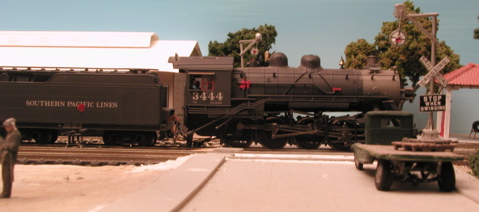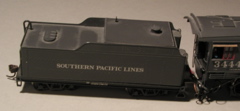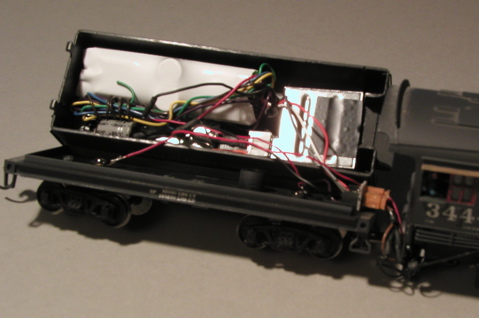
3444 pulls a freight train past the Market Street Station
Now, the Bachman locomotive certainly doesn't look like a common SP consolidation; it's much too "chunky" and the ladders on the front end certainly aren't a common SP feature. To get around this, I looked at the uncommon Consolidations in "Century of Southern Pacific Steam", a great book showing the range of Southern Pacific locomotives. One of these was the class C-26 locomotives that matched the Bachman well. These locomotives were built for the El Paso and Southwest railroad, and inherited by the SP when they bought the EP&SW. The locomotives went to the SP's Mexican subsidiary in the 1920's, but saw some use in the States during World War II.
To make the locomotive resemble the C-26, I added number boards and converted the tender to oil by making a new oil bunker top from sheet styrene. The paint job made the greatest change -- the graphite smokebox and red fittings completed the transformation. I again tried to use a lightened black as the base color. However, I'm not happy with the final color. I'm not sure if I chose too light a color, if the Polly-Scale paints just look different than Floquil paints, or if the plastic model just is destined to look different. I didn't bother to paint the running gear; it's still a darker black.

Sheet styrene oil bunker on stock tender
The Bachmann was already wired for DCC, but I did some further modifications. I added a Soundtraxx DCC decoder. The decoder's in the tender along with an edge-port speaker pointing out the front of the tender. Both of these squeeze into the tender. The decoder is at the back, double-stick taped to the tender, and arranged to one side to miss the screw securing the tank body to the frame. tender. The speaker fits at the front of the tender. The existing circuit board in the tender was removed; the decoder's hardwired to the connector for wires from the locomotive and to wires from the tender rucks. The worst part of installing the decoder was accidentally pinching the wires to the headlight when disassembling the engine. The tender connector's fragile -- wires have broken in the past.

Inside the Bachmann tender
It's a great locomotive -- it runs well and can pull more cars than many of the brass locomotives. One of the gears did split after around ten years of use; I ended up buying another Bachman from a hobby shop, and swapped the mechanism to get the locomotive running again.